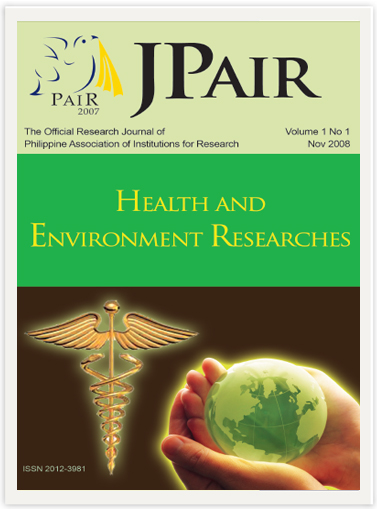Physical Activity Profile of Older Elementary School Children of Batac, Ilocos Norte using the Modified Physical Activity Questionnaire for Older Children
DOI:
https://doi.org/10.7719/jpair.v1i1.35Keywords:
Physical Activity, Children, Modified Physical Activity Questionnaire, HealthAbstract
Physical activity has been consistently shown to have strong positive correlations with both physical and mental health benefits for adults and children alike, supporting the importance of early intervention programs to promote lifelong healthy habits. However, despite these benefits, there is a notable lack of local studies examining the physical activity levels of Filipino children, contrasting with the extensive foreign literature available. To address this gap, a study was conducted in Batac, Ilocos Norte, using the Modified Physical Activity Questionnaire for Children (MPAQ-C) among 238 elementary school students aged 8 to 12 years. The results showed that "tagging" was the most common activity (7.509%), while "karate" was the least (3.325%). Children were most active during weekends but showed restricted activity on school days, with mild activity in PE classes often limited to classroom work. Outside school, they engaged in sports, dance, or play. Mean physical activity peaked at age 10 and declined by age 12, though ANOVA revealed no significant differences across age groups (f value = 1.135, a = 0.05). Height was the only variable significantly affecting physical activity levels (r = 0.173), indicating taller children may be more inclined to engage in physical activities. Overall, the study highlights the need for targeted interventions to enhance physical activity among Filipino children, reinforcing its importance in their development and suggesting that educators and policymakers can develop more effective strategies by understanding these patterns and factors.
Downloads
References
Caspersen, C. J., Powell, K. E., & Christenson, G. M. (1985). Physical activity, exercise, and physical fitness: Definitions and distinctions for health-related research. Public Health Reports, 100, 126–133.
Downloads
Published
Issue
Section
License
Copyright (c) 2008 Manuel Ted F. Aurelio

This work is licensed under a Creative Commons Attribution-NonCommercial 4.0 International License.
Open Access. This article published by JPAIR Multidisciplinary Research is licensed under a Creative Commons Attribution-Noncommercial 4.0 International (CC BY-NC 4.0). You are free to share (copy and redistribute the material in any medium or format) and adapt (remix, transform, and build upon the material). Under the following terms, you must give appropriate credit, provide a link to the license, and indicate if changes were made. You may do so in any reasonable manner, but not in any way that suggests the licensor endorses you or your use. You may not use the material for commercial purposes.




















